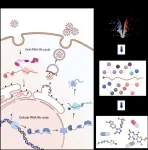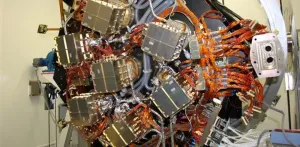Recently, we have witnessed the first promising examples of biological age reversal by experimental interventions. Indeed, many biological clock types properly predict more years of life for those who choose healthy lifestyles or quit unhealthy ones, such as smoking. What has been still unknown is how quickly biological age is changing over time for the same individual. And especially, how one would distinguish between the transient fluctuations and the genuine bioage change trend.
The emergence of big biomedical data involving multiple measurements from the same subjects brings about a whole range of novel opportunities and practical tools to understand and quantify the aging process in humans. A team of experts in biology and biophysics presented results of a detailed analysis of dynamic properties of the fluctuations of physiological indices along individual aging trajectories.
Healthy human subjects turned out to be very resilient, whereas the loss of resilience turned out to be related to chronic diseases and elevated all-cause mortality risks. The rate of recovery to the equilibrium baseline level after stresses was found to deteriorate with age. Accordingly, the time needed to recover was getting longer and longer. Being around 2 weeks for 40 y.o. healthy adults the recovery time stretched to 6 weeks for 80 y.o. on average in the population. This finding was confirmed in two different datasets based on two different kinds of biological measurements - blood test parameters on one hand and physical activity levels recorded by wearable devices on the other hand.
"Calculation of resilience based on physical activity data streams has been implemented in GeroSense iPhone app and made available for the research community via web-based API." - commented the first author of the study, Tim Pyrkov, head of the mHealth project at Gero.
If the trend holds at later ages, the extrapolation shows a complete loss of human body resilience, that is the ability to recover, at some age around 120-150 y.o. The reduced resilience was observed even in individuals not suffering from major chronic disease and led to the increase in the range of the fluctuations of physiological indices. As we age, more and more time is required to recover after a perturbation, and on average we spend less and less time close to the optimal physiological state.
The predicted loss of resilience even in the healthiest, most successfully aging individuals, might explain why we do not see an evidential increase of the maximum lifespan, while the average lifespan was steadily growing during the past decades. The divergent fluctuations of physiological indices may mean that no intervention that does not affect the decline in resilience may effectively increase the maximum lifespan and hence may only lead to an incremental increase in human longevity.
Aging in humans is a complex and multi-stage process. It would, therefore, be difficult to compress the aging process into a single number, such as biological age. Gero's work shows that longitudinal studies open a whole new window on the aging process and produce independent biomarkers of human aging, suitable for applications in geroscience and future clinical trials of anti-aging interventions.
"Aging in humans exhibits universal features common to complex systems operating on the brink of disintegration. This work is a demonstration of how concepts borrowed from physical sciences can be used in biology to probe different aspects of senescence and frailty to produce strong interventions against aging.", - says Peter Fedichev, co-founder and CEO of Gero.
Accordingly, no strong life extension is possible by preventing or curing diseases without interception of the aging process, the root cause of the underlying loss of resilience. We do not foresee any laws of nature prohibiting such an intervention. Therefore, the aging model presented in this work may guide the development of life-extending therapies with the strongest possible effects on healthspan.
"This work by the Gero team shows that longitudinal studies provide novel possibilities for understanding the aging process and systematic identification of biomarkers of human aging in large biomedical data. The research will help to understand the limits of longevity and future anti-aging interventions. What's even more important, the study may help to bridge the rising gap between the health- and life-span, which continues to widen in most developing countries." - says Brian Kennedy, Distinguished Professor of Biochemistry and Physiology at National University Singapore.
"This work, in my opinion, is a conceptual breakthrough because it determines and separates the roles of fundamental factors in human longevity - the aging, defined as progressive loss of resilience, and age-related diseases, as "executors of death" following the loss of resilience. It explains why even most effective prevention and treatment of age-related diseases could only improve the average but not the maximal lifespan unless true antiaging therapies have been developed" - says prof. Andrei Gudkov, PhD, Sr. Vice President and Chair of Department of Cell Stress Biology at Roswell Park Comprehensive Cancer Center, a co-author of this work and a co-founder of Genome Protection, Inc., a biotech company that is focused on the development of antiaging therapies/.
"The investigation shows that recovery rate is an important signature of aging that can guide the development of drugs to slow the process and extend healthspan." - commented David Sinclair, Harvard Medical School professor of genetics.
"The research from Gero surprisingly comes to a similar quantification of human resilience - a proposed biomarker of ageing - based on two very different kinds of data: blood test parameters on one hand and physical activity levels recorded by wearable devices on the other hand. I'm very excited to see how Person-generated Health Data, including data from commercial wearables, can help create individual, longitudinal profiles of health that will be instrumental to shed light on lifetime-scale health phenomena, such as ageing." - commented Luca Foschini, Co-founder & Chief Data Scientist at Evidation Health.
Two aging markers
The authors characterized the dynamics of physiological parameters on time scales of human lifespan by a minimum set of two parameters. The first is an instant value, often referred to as the biological age, and is exemplified in this work by the Dynamic Organism State Index (DOSI). The quantity is associated with stresses, lifestyles and chronic diseases and can be computed from a standard blood test.
The other parameter - the resilience - is new and reflects the dynamic properties of the organism state fluctuations: it informs how quickly the DOSI value gets back to the norm in response to stresses.
When does aging start?
Age-related changes in physiological parameters start from birth. However, various parameters change in different ways at different stages of life, see, e.g., a previous work by the same authors published in Aging US in 2018). The data from the Nature Communications work shows that there is a good differentiation between the growth phase (mostly complete by the age of 30 and following the universal growth theory by Geoffrey West and aging. At 40+ years, aging manifests itself as a slow (linear, sub-exponential) deviation of physiological indices from their reference values.
How often should one measure biological age?
Physiological parameters are naturally subject to fluctuations around some equilibrium level. Glucose levels rise and drop after having a meal, the number of sleeping hours is slightly different each day. Yet, one can collect a longitudinal dataset, that is a series of such measurements for the same person, and observe that the average levels are different between individuals. Resilience also requires repeated measurements, since one needs to know exactly when recovery was achieved to calculate the resilience.
Importantly, resilience also provides a convenient guide on how often repeated measurements should be taken. As a rule of thumb, the period of observation required for the robust bioage determination should comprise multiple stress and recovery events. For the most healthy individuals such an observation period would amount to several months and should increase with age. During that time, a robust bioage determination would require several data points per recovery time, that is ideally one measurement in a few days.
Wearable technology comes into play
In 2021, the only practical way to achieve a high (once-per-day or better) sampling rate is to use mobile/wearable sensor data.
In another paper, the authors have focused on wearable/mobile sensor data. They have built "wearable DOSI", which they called GeroSense and reported its validation tests in Pyrkov et al. Aging (Albany NY) 13.6 (2021): 7900. GeroSense can be used to compute resilience. Population study shows that the number of individuals showing signs of the loss of resilience increases exponentially with age and doubles every 8 years at a rate matching that of the Gompertz mortality law (the observation by B. Gompertz from 1827, who observed for the first time that the all-cause mortality rate doubles every 8 years).
INFORMATION:
About Gero
Gero is a data-driven biotech company applying modern AI/ML tools to big longitudinal biomedical data to understand aging and major diseases.
Gero AI/ML models are originating from the physics of complex dynamic systems. We have presented our unique approach in Frontiers in Genetics (Fedichev 2018, Frontiers in genetics 9:483). We combine the potential of deep neural networks with the physical models to study human health as a dynamic process. In conjunction with high-quality genetics data, we produce quantitative explanatory models of (aka theory of) aging and complex diseases, as well as actional drug target hypotheses.
Gero conducts high-quality research in collaborations with Harvard Medical School, Massachusetts Institute of Technology, University of Edinburgh, National University of Singapore, Moscow Institute of Physics and Technology, and Roswell Park Comprehensive Cancer Center. The company is a regular contributor to peer-reviewed journals.
Gero has developed a unique framework "GeroSense" for continuous day-to-day monitoring of biological age based on data streams of mobile and wearable sensors. "GeroSense" provides biological age monitoring in our free iPhone app.
Gero encourages using "GeroSense" via web API for monitoring of anti-aging and pro-longevity effects of therapies as well as lifestyle choices, physical activities, diets, food supplements, recommended by health/fitness and wellness apps (see https://techcrunch.com/2021/05/07/longevity-startup-gero-ai-has-a-mobile-api-for-quantifying-health-changes/).
Gero is funded by AI champions, including AIMATTER founders (recently acquired by Google). In 2019 and 2021, Gero was also named one of the leading companies in artificial intelligence in life extension along with Google and IBM.
About Roswell Park Comprehensive Cancer Center
Roswell Park Comprehensive Cancer Center is a community united by the drive to eliminate cancer's grip on humanity by unlocking its secrets through personalized approaches and unleashing the healing power of hope. Founded by Dr. Roswell Park in 1898, it is the only National Cancer Institute-designated comprehensive cancer center in Upstate New York. Learn more at http://www.roswellpark.org, or contact us at 1-800-ROSWELL (1-800-767-9355) or ASKRoswell@RoswellPark.org.






